Yangon, formerly Rangoon in Myanmar, is changing rapidly, with more visitors arriving every year.
The city has many notable sites but mainly revolves around Shwedagon Paya – a sacred golden Buddhist monument surrounded by pretty parks and lakes.
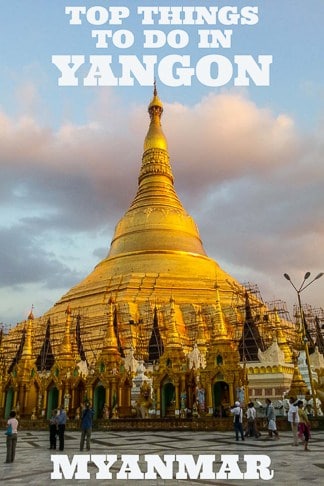
Travel Guide and top things to do in Yangon, the largest city in Myanmar / Burma
In the downtown area of Yangon, there are further temples, open-air markets, museums and colonial architecture to explore.
Top Things To Do In Yangon
Explore Shwedagon Pagoda

Shwedagon Pagoda
Shwedagon Pagoda glistens in gold – a gilded stupa in the heart of the city.
It’s the most sacred Buddhist site in this region of Myanmar and believed to have been built over 2,600 years ago.
The stupa is said to house relics of four Buddhas, including the robe of Kassapa, the staff of Kakusandha, hair from the head of Gautama and the water filter of Konagamana.
The pagoda itself is built on a hill, standing 112 metres tall, illuminating the skyline.

Shwedagon Pagoda
As you wander around the structure, you’ll see it is decorated with lotus petals, an inverted alms bowl, bell and a crown.
The crown itself is topped with over 5400 precious diamonds and over 2300 rubies, and on the tip – the diamond bud features a stunning 76-carat diamond!

Shwedagon Pagoda
If you have limited time in Yangon and aren’t sure what to see, make sure Shwedagon Pagoda is on your list.

Local Buddhist prying in front of Shwedagon Pagoda
Some of the best views and photographs can be taken from the shores of the nearby lake, so you can enjoy a picnic whilst you admire centuries of architecture.
Shwedagon Pagoda is defiantly one of the most impressive Religious buildings in Asia.
Relax by Kandawgyi Lake
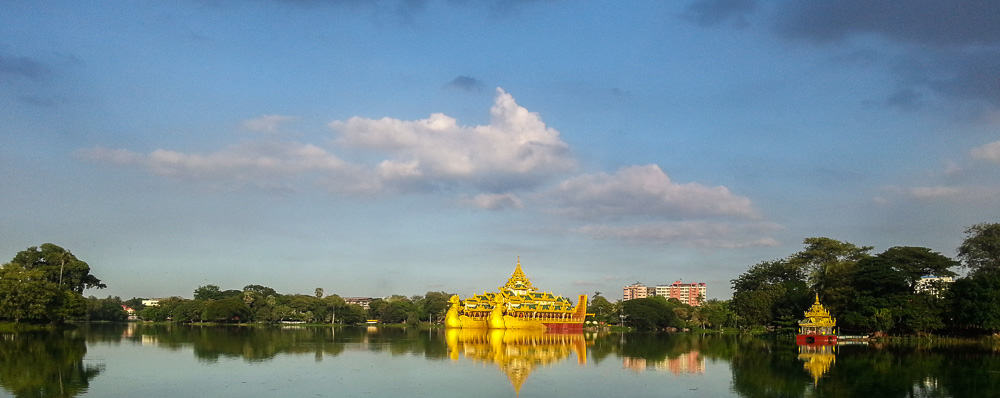
Kandawgyi Lake
This is one of two major water features in Yangon, situated east of Shwedagon Pagoda.
It’s a tranquil space surrounded by trees and winding pathways which offer incredible views of Karaweik – (a replica of a Burmese royal barge) in the distance.

A replica of a traditional Burmese royal boat in Kandawgyi Lake
Take a picnic, indulge in outdoor activities or photograph wildlife.
The lakeside paths allow easy walking access to Kandawgyi Nature Park and Yangon Zoo with a natural history museum, amusement park and aquarium, so there’s something to entertain the whole family.
Visit the Reclining Buddha at Chaukhtatgyi Temple
Located on Shwe Gon Daing Road, the Buddha at Chawkhtatgyi Temple is the largest reclining Buddha in the world.
The Buddha was originally built in 1907 to be an outdoor statue.
However, this was destroyed during the Second World War, rebuilt in 1953 and placed indoors for protection.
As you venture into the temple, you’ll notice on the soles of Buddha’s feet there are 108 grids.
These contain aspects of the human world, animal world and god’s worlds, representing the 108 reincarnations of people.
Even if you’re not religious at all, this reclining masterpiece within a short walk of Shwedagon Pagoda is incredibly impressive and worth visiting when in Yangon.
Try the National Dish Mohinga
If you enjoy sampling local cuisine, you should try Myanmar’s national dish, Mohinga.
This fish-based soup, native to southern Burma, is made with rice noodles and is a popular breakfast dish for locals.
Every village, city and restaurant prepares Mohinga in their own way, depending on local ingredients and fish available; however, the traditional recipe is the same wherever you go.
The breakfast bowl is made with locally caught fish (usually catfish or tilapia), chickpea or rice flour, onion, lemongrass, ginger and garlic.
You can often find delicious variations courtesy of street hawkers who wander the neighbourhoods carrying cauldrons on a wooden pole over their shoulders!
Make a Stop at Botataung Pagoda
Botataung Pagoda was built by the Mon people around the same time as Shwedagon Pagoda.
You may think, “seen one pagoda in Yangon, seen them all”, but each structure has its own individual story.
This one is named after the one thousand military offers which were tasked to perform a guard of honour when Buddha’s relics were brought from India to Burma (now Myanmar) over 2000 years ago.
The original pagoda was destroyed during the Second World War, but the new pagoda still captivates the imagination.
Inside, it has a unique hollow interior with a mirrored maze walkway leading to a collection of ancient relics and unusual artefacts.
Stroll through Yangon’s Chinatown
Yangon’s Chinatown can be found around 19th street and downtown Yangon near Sule Pagoda.
This area of Yangon was created in the 1850s when the British invaded, and today, the bustling quarter is home to over 150,000 Chinese people.
You can explore ancient temples and pagodas, feast on traditional Chinese food such as tofu, wontons and dumplings or shop for souvenirs at the buzzing night market.
If you’re visiting during the Chinese Lunar New Year, you can also become part of the colourful festival atmosphere with processions, live dance and musical performances.
See Stupas at Sule Pagoda
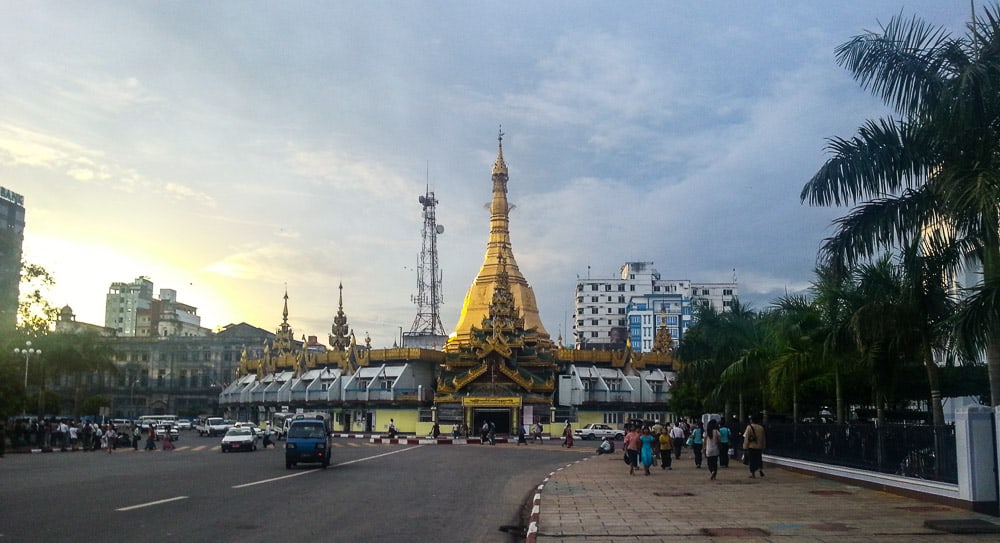
Sule Pagoda
This striking pagoda, originally built around 2,500 years ago, was a strategic location for the British during the colonial era.
They used the pagoda to begin an ambitious town planning project, creating a grid pattern around the structure to expand Yangon’s streets.
In later years it was used as a meeting point for Burmese royalty, and more recently, it became a place for rallies and demonstrations during the country’s uprising.
Sule Pagoda is characterised by a golden dome standing 152 feet tall and a distinctive octagonal shape with 8 Buddha images, 10 bronze bells and smaller stupas around it.
It is a great place to begin a city exploration due to its central location, close to many landmarks, including thriving street markets of Mahabandoola Road.
Visit the National Museum
This is one of two national museums dedicated to Burmese history, art and culture in Myanmar.
It was founded in the early 1950s, and across the five levels, you’ll see a collection of ornaments, artwork, inscriptions and historic memorabilia.
There are over 4000 permanent objects on display. However, the main attraction is the surviving Lion Throne of the Burmese monarchs.
If you want to learn more about this fascinating country and its people, this is the place to visit.
Gain the Best Views of Yangon from Maha Wizaya Pagoda
Set atop a scenic hillside in Yangon is Maha Wizaya Pagoda, offering unrivalled vistas of the city.
The pagoda is one of the city’s contemporary offerings built in 1980 with a dome ceiling painted in blue and decorated with ceiling frescoes and reliefs.
Inside the structure, you can also see relics contributed by the Nepalese King and outside in the lakes and ponds, turtles swim, oblivious to tourists visiting for the views.
Travel around Yangon on the Circular Train
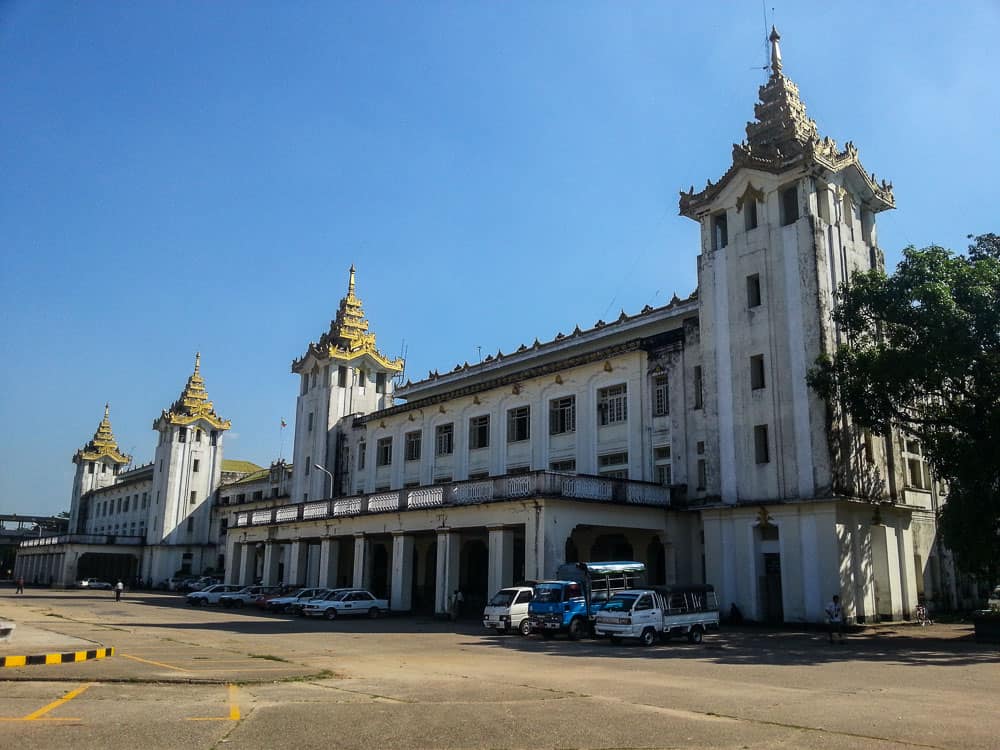
Yangon Central railway station from where you can take the circular train
One of the best ways to see Yangon and meet friendly locals is on Yangon’s circular train line.
This train line was built in 1954 by the British, and it covers a loop track of around 45 kilometres stopping at 39 stations!
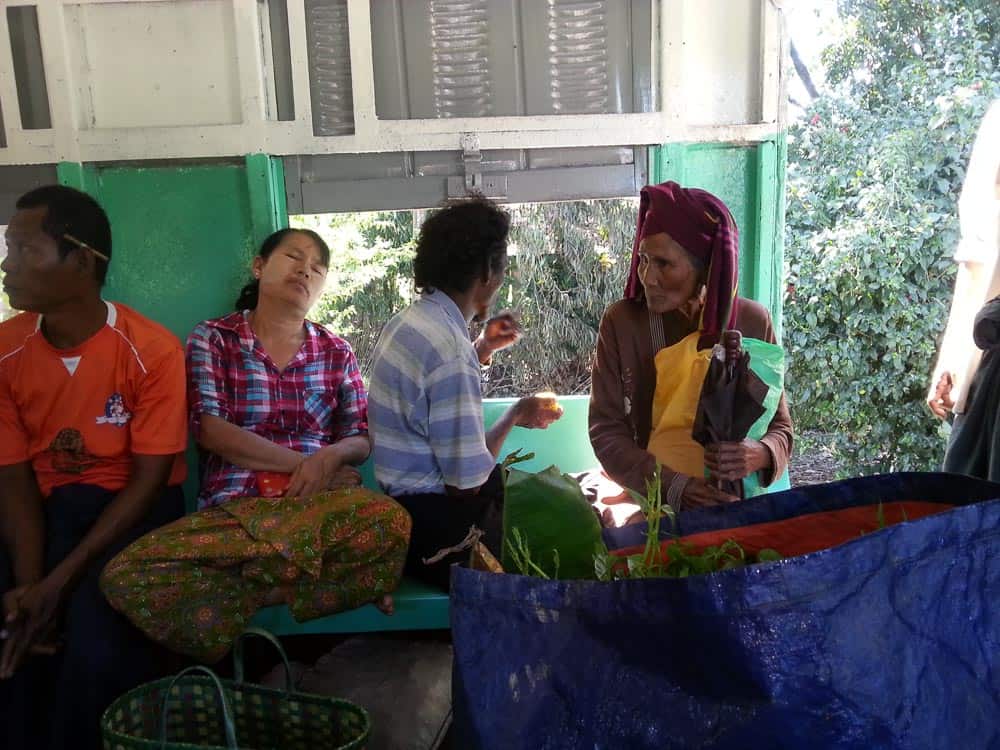
Life on the circular train
It takes around 3 hours to complete the full journey, but you’ll be able to hop on and off at places of interest or simply take your camera and enjoy the scenery of the city and its surrounding countryside!
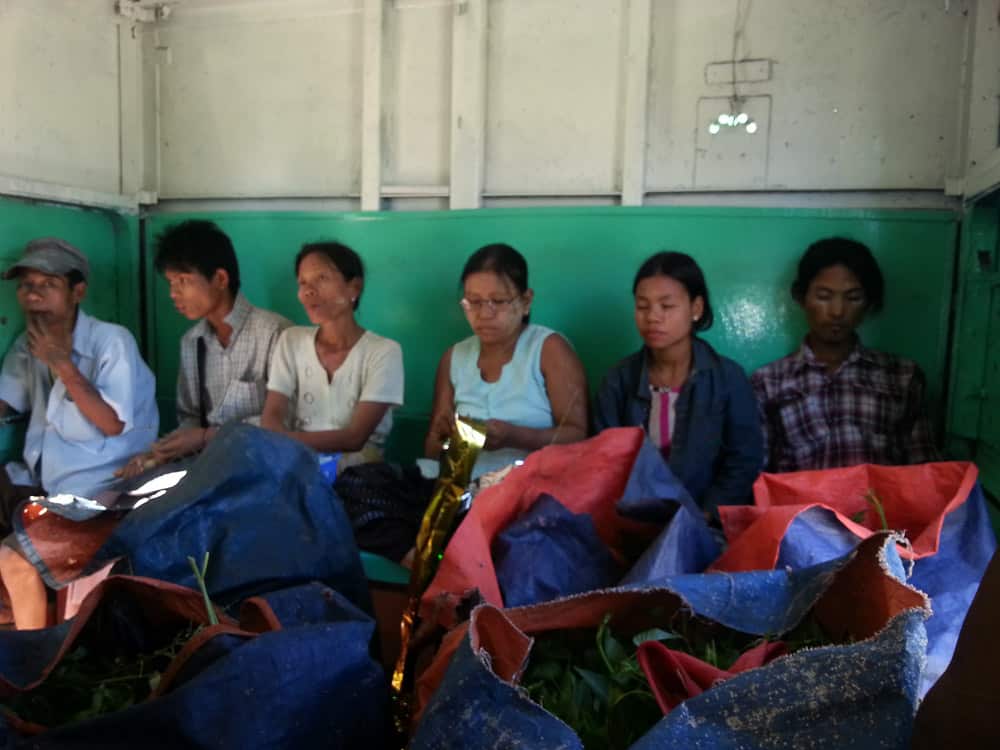
Local life on the circular train
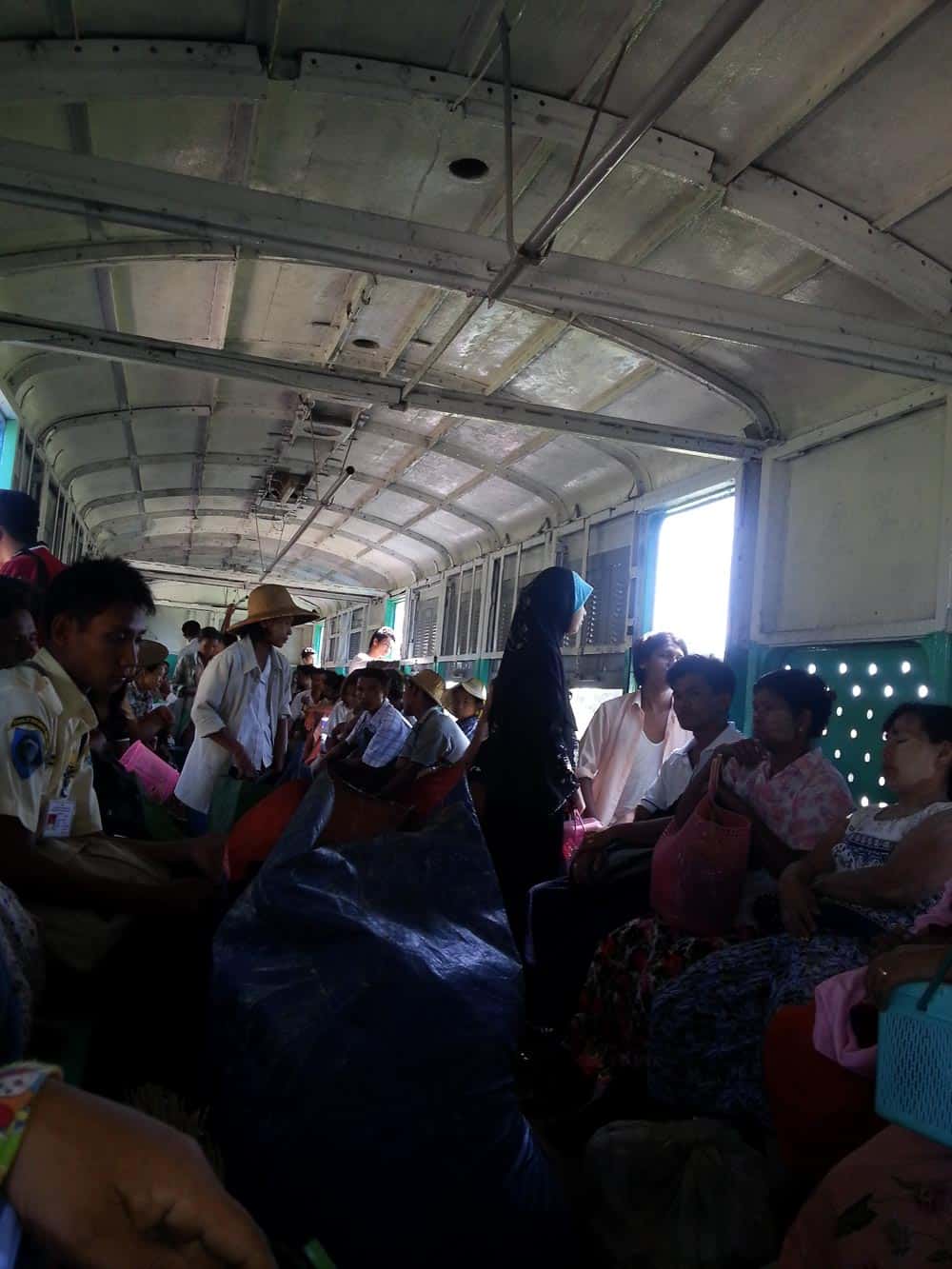
The circular train can get very crowded.
It may not be the most comfortable train in the world, but as you’ll see lively street markets, museums and historic residences on your journey, so it’s worth it!
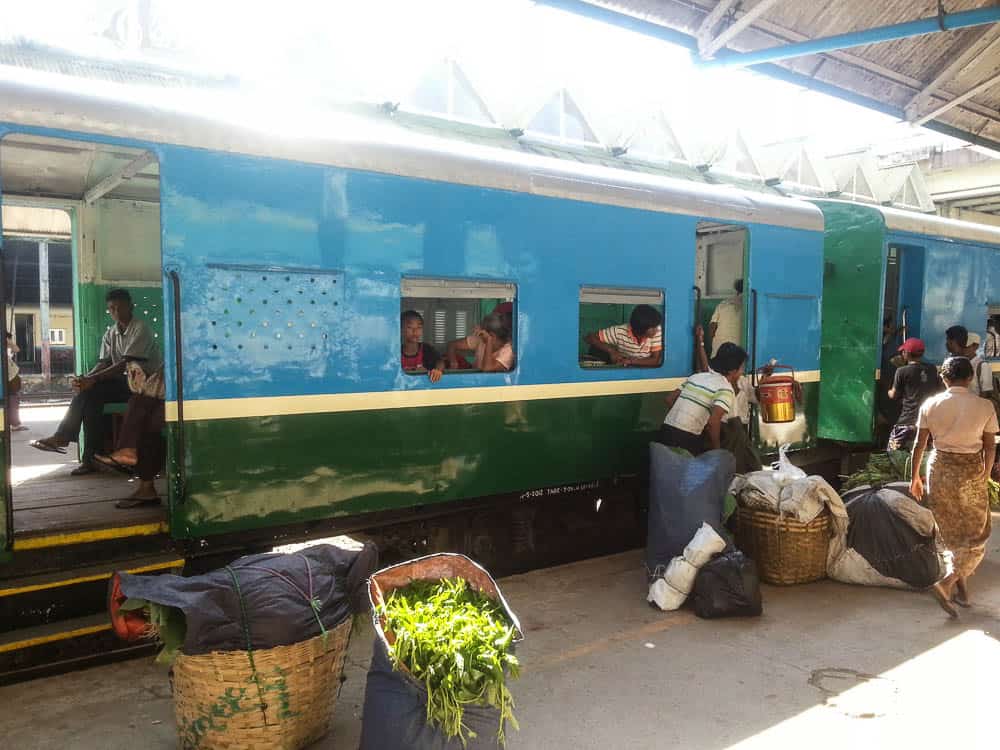
Getting ready for the circular train
Go Shopping at Bogyoke Aung San Market
If you want to shop till you drop, head for Bogyoke Aung San Market on a street of the same name.
This popular indoor market caters to locals and tourists and has been here since 1926.
Today, there are over 1600 shops in total, selling handicrafts, food items, clothing, jewellery, luxury goods and electronics.
If you want to try traditional Myanmar or Chinese food, there are also plenty of stalls here serving tasty delicacies.
Enjoy a Day out at Thanlyin
Thanlyin, around 20 kilometres outside Yangon, dates to the 7th century and is set aside the Irrawaddy Delta.
It was once an important port town until other routes rendered it an abandoned suburb of Yangon.
It forms the basis of a perfect day trip for its incredible views, island temples and pagodas, which can only be reached by boat.
Discover Myanmar’s Wildlife at Hlawga National Park
If you’re a keen photographer and want to see nature in all its glory, head for Hlawga National Park 35 kilometres outside Yangon.
This national park is home to rare species, including leopards, tigers, bears, birds and pythons.
The best way to see everything is on a guided tour, as these knowledgeable experts know exactly where to sight the animals at specific times of the day.
If you wish to extend your visit and fully connect with nature, there are options to stay overnight in eco-lodges, on boathouses and to hike the dense jungle terrain.
How to Get to Yangon
Yangon International Airport sits less than 10 kilometres northwest of Downtown.
As the country is located between China and India, it’s accessible by most Asian and Middle Eastern countries via direct flights.
There are also indirect flights from several major European and US cities. A total of 34 airlines operate from 33 international destinations, and 5 airlines run frequent domestic route services.
Should you prefer to travel to Yangon by train, Yangon Central Railway Station is Myanmar’s major rail hub with services to Mandalay, Shwebo, Naypyidaw, Shan Hills, Taninthayi Coast and upcountry locations.
If you are travelling across borders, bus services operate from Bangkok, Thailand to Yangon with a transfer at Mae Sot on the Thai/Myanmar border.
Journeying by bus is also the most cost-effective way to reach other areas of Myanmar.
There are bus routes from Yangon to Mandalay, Bagan and more, and you can choose from different levels of comfort with reclining seats and overnight services on some routes.
